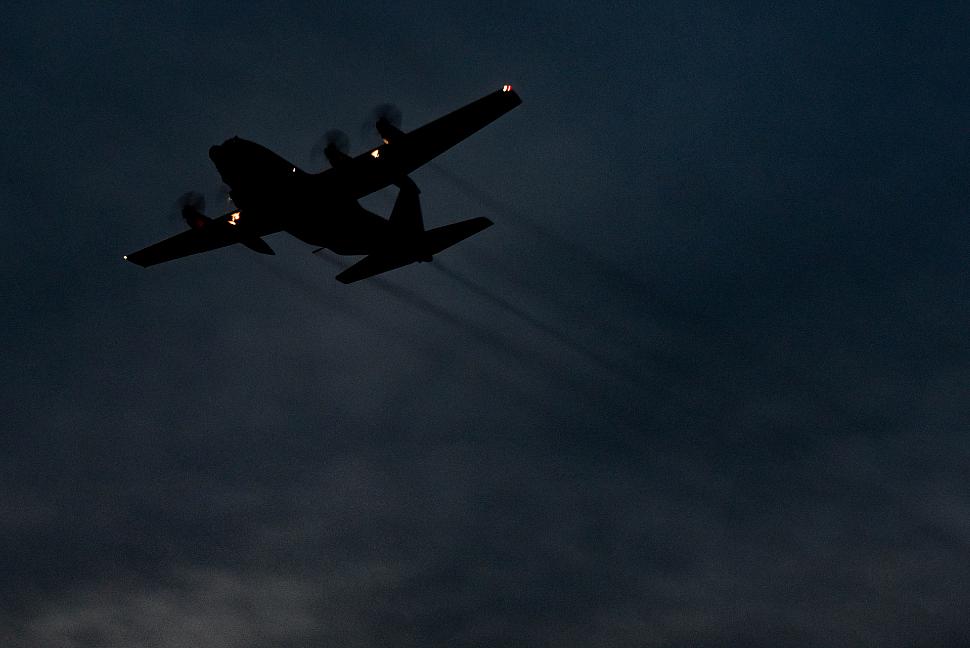C-130 News
C-130 Hercules News
Mosquito spraying comes full circle
August 8, 2017 (by
SSgt. Carlin Leslie ) -
In 1947, the U.S. Air Force activated the 4500th Aerial Spray Flight, whose mission was to minimize vector borne diseases and reduce troop loss during the war, at Langley Field.

Fast forward 70 years, the unit returned to Langley Air Force Base under its new name, the 757th Airlift Squadron, which is stationed at the 910th Airlift Wing at Youngstown Air Reserve Station, Ohio. During its visit, the 757th AS successfully completed its unique mission once again over Langley AFB and Craney Island, on August 1, 2017.
"Our number one focus area in Air Combat Command and Joint Base Langley-Eustis is readiness," said Lt. Col. Kevin Osborne, 633rd Civil Engineer Squadron commander. "With the support from the 757th AS, we are ensuring disease transmitting species, or mosquitos, are not given the chance to impact our Airmen's ability to support the warfighting mission."
The local spray mission, which occurred after sunset to minimize exposure, was accomplished through multiple passes. The unit applied 90 gallons of TRUMPET EC, in what Maj. Jennifer Remmers, 757th AS entomologist, described as, "Throwing a shot glass of water over an acre of land."
"The uniqueness of our system cannot be matched in the civil world, just in the sheer area that we can cover in a disaster response or on mission," said Remmers, "We are flying at 300 feet, at 200 knots, covering a swath width of 2,000 for multiple passes, like mowing the lawn."
The 757th AS is the only unit that provides the aerial spraying mission within the Department of Defense, covering all stateside bases for Joint Service readiness. The spraying is conducted using C-130 Hercules aircraft equipped with a Modular Aerial Spray System to complete the mission.
The C-130s are specially modified with spray arms and the MASS, which can carry a total of 2,000 gallons of insecticide, herbicide or dispersant. The agent is then disbursed out of spray bars under each wing, in 30-micron droplets. A technician also mans all operations of the spray rate and flow with the direction of a 757th AS entomologist.
Additionally, the team uses global positioning and other accurate navigation systems to ensure that the spaying occurs only over designated areas.
"The spray team is highly trained, and wind speed and direction was accounted for to ensure precise application to the target areas using Environmental Protection Agency-registered insecticides," said Osborne.
With the help of the 757th AS Airmen assigned to Langley AFB are afforded the opportunity to continue supporting the Air Force's warfighting mission sans the threat of vector borne diseases.
A USAF C-130 Hercules assigned to the 757th AS sprays for mosquitos over Joint Base Langley-Eustis on August 1, 2017. The C-130 is modified to carry a palletized Modular Aerial Spray System, which is attached to the spray bars fitted to the aircraft. [USAF photo by SSgt. Carlin Leslie]
"Our number one focus area in Air Combat Command and Joint Base Langley-Eustis is readiness," said Lt. Col. Kevin Osborne, 633rd Civil Engineer Squadron commander. "With the support from the 757th AS, we are ensuring disease transmitting species, or mosquitos, are not given the chance to impact our Airmen's ability to support the warfighting mission."
The local spray mission, which occurred after sunset to minimize exposure, was accomplished through multiple passes. The unit applied 90 gallons of TRUMPET EC, in what Maj. Jennifer Remmers, 757th AS entomologist, described as, "Throwing a shot glass of water over an acre of land."
"The uniqueness of our system cannot be matched in the civil world, just in the sheer area that we can cover in a disaster response or on mission," said Remmers, "We are flying at 300 feet, at 200 knots, covering a swath width of 2,000 for multiple passes, like mowing the lawn."
The 757th AS is the only unit that provides the aerial spraying mission within the Department of Defense, covering all stateside bases for Joint Service readiness. The spraying is conducted using C-130 Hercules aircraft equipped with a Modular Aerial Spray System to complete the mission.
The C-130s are specially modified with spray arms and the MASS, which can carry a total of 2,000 gallons of insecticide, herbicide or dispersant. The agent is then disbursed out of spray bars under each wing, in 30-micron droplets. A technician also mans all operations of the spray rate and flow with the direction of a 757th AS entomologist.
Additionally, the team uses global positioning and other accurate navigation systems to ensure that the spaying occurs only over designated areas.
"The spray team is highly trained, and wind speed and direction was accounted for to ensure precise application to the target areas using Environmental Protection Agency-registered insecticides," said Osborne.
With the help of the 757th AS Airmen assigned to Langley AFB are afforded the opportunity to continue supporting the Air Force's warfighting mission sans the threat of vector borne diseases.
Courtesy of 633rd Air Base Wing Public Affairs
Related articles:
Forum discussion:
Tags
Forum discussion:
- Start a discussion about this article in the C-130.net forum.
Tags
